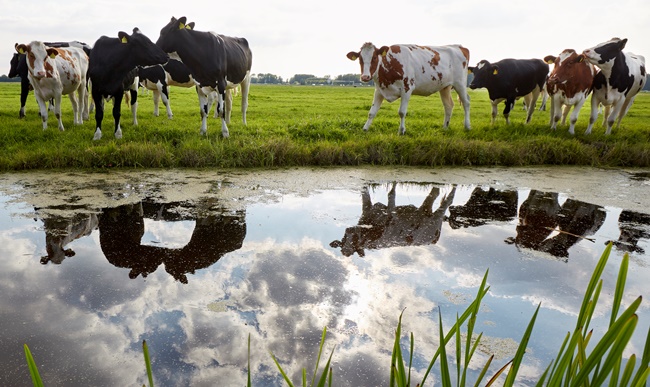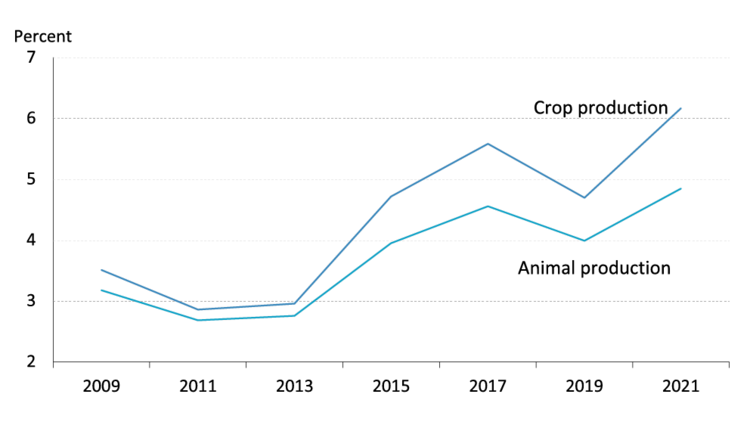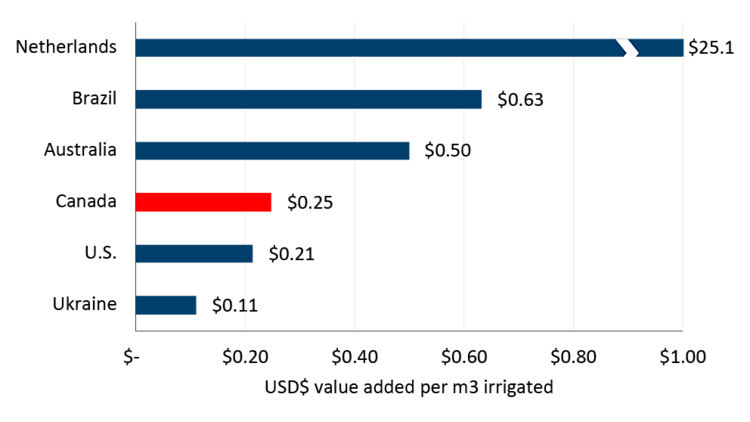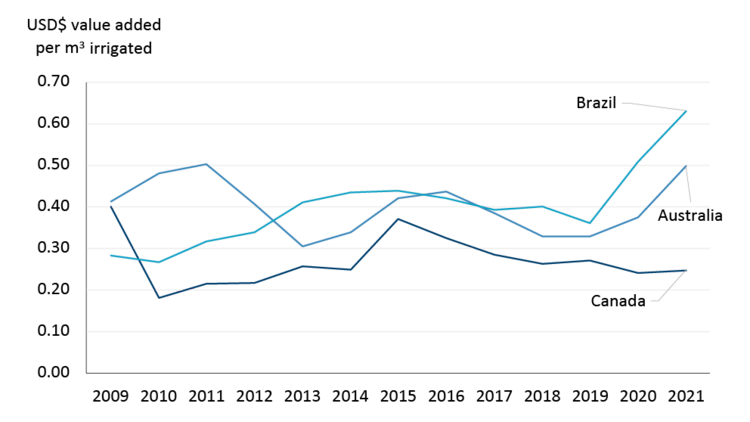FCC report: Improved water efficiency can make a splash in Canadian agriculture

Rain makes grain. Adequate rainfall during the growing season is essential for good yields. This highlights the crucial role water plays in Canadian agriculture and the food we eat
by Leigh Anderson – Farm Credit Canada (FCC)
Yet, perhaps because of public perceptions of ample water resources, Canadians may not make this connection. Rather it’s during times of extreme drought when the precious resource gets the attention it deserves.
Water usage has indeed surged in the agricultural sector in recent years due to dry conditions. The latest Canadian System of Environmental–Economic Accounts, which was released last July, shows more than two billion cubic metres were used for crop production in 2021, representing 6.1% of industrial water usage (Figure 1). Including animal production, agriculture’s share of industrial water usage was a record 11%.
So, how significant is the increase in agriculture water usage and how does Canada compare to other major agriculture producers around the world?
Figure 1: Canadian agriculture’s share of total industrial water usage
Sources: Statistics Canada, FCC calculations
How do we compare to others?
To answer that question, we used Aquastat, a United Nations database. Aquastat looks at agriculture water usage as a share of total water withdrawal (total water withdrawal includes agriculture, industrial and municipal), which is not comparable to Statistics Canada’s above-mentioned data, but useful nonetheless because it is standardized and allows for cross country comparisons.
As it turns out, Canada’s agricultural water usage is relatively low compared to major global agricultural exporters (Figure 2) with the exception of the Netherlands – the latter is in a category of its own due to the efficient water management practices including the use of advanced irrigation techniques and the reuse of wastewater for agricultural purposes.
Figure 2. Agricultural water usage as a share of total water withdrawal
Sources: UN FAO AQUASTAT, FCC calculations
While Canada does relatively well in its overall agriculture water usage, that’s not to say things cannot be improved. For instance, the country could be doing better in water usage efficiency, defined here as value added per cubic metres of irrigated agricultural land. According to Aquastat data, Canada generates about USD$0.25 in value added per cubic metre of irrigated land (Figure 3). While better than the U.S., and Ukraine, that’s below Australia, Brazil and the Netherlands. As mentioned above, the Netherlands is in a category of its own due to high efficiencies but also due to high-value crops such as flowers and high-end vegetables, meaning replicating its success is not realistic. But replicating efficiencies of Brazil and Australia, which produce largely similar crops to Canada, can be considered.
Figure 3. Irrigated Agriculture Water Use Efficiency in 2021
Source: UN FAO AQUASTAT
Australia and Brazil have faced drought conditions and water scarcity but undertook initiatives to improve water usage and boost their value added per cubic metres of irrigated land. They implemented effective water management practices like scheduling irrigation based upon crop needs and weather conditions to optimize water use. Technological advancements played a large role including smart irrigation and sensors. Brazil reduced its traditional flood irrigation methods to more efficient drip irrigation. Canada has lagged those countries on water use efficiency for more than a decade, and the gap has widened since 2015 in part because of droughts (Figure 4).
Figure 4. Irrigated agricultural water use efficiency
Sources: UN FAO AQUASTAT, FCC calculations
Clearly, there is room for improvement with regards to water use efficiency. With the right investments, Canada could produce more with less water. This is much in line with our long-standing view that boosting productivity in the agriculture sector can be very lucrative for Canada.
Investing for efficiency: doing more with less water
So, what types of investments are we talking about here?
It’s true that over the past few decades, the agriculture sector has made investments, such as switching from high-pressure to low-pressure pivots. Some have also added corner arms to these pivots. This change has increased the amount of land that can be irrigated by almost 20%. At the irrigation district level, open canals have been swapped for concrete pipelines, limiting evaporation before the water reaches the field.
What else can be done to achieve better water usage efficiencies?
For instance, smart irrigation systems, which include temperature and soil sensors that pick the best times to water crops, are proven water savers. They also help with improved tracking of water usage that allow farmers to compare their performance against benchmarks and identify continued areas for improvement, saving water and cutting down on energy costs in the process. Another option is subsurface irrigation, which involves installing pressurized water pipes underground and uses significantly less water than a traditional pivot since no evaporation occurs. Some Canadian producersbeing early adopters have invested in this with preliminary indications it has potential to reduce water usage by as much as 50% since it delivers water right directly to plant roots. A reduction in water usage means more acres could be irrigated and/or reductions in water allocations could be mitigated.
In addition to upgrading irrigation systems, farmers can also expand implementation of best land management practices including crop rotations suited for dry conditions, planting of drought-tolerant varieties and limiting tillage, all of which can be effective water savers.
The above-mentioned investments, while not cheap, offer farmers a shield against future droughts. And that can help smooth out the volatility in harvests and therefore farm profitability over the long run. Government programs can help reduce costs of such investments for farmers. Many of the programs are through the federal-provincial-territorial initiative Canadian Agricultural Partnership (CAP) that provides funding for projects that improve water management, irrigation systems or water for livestock. Farmers interested can access funding through their provincial government websites which include various other programs.
Bottom line
Recent droughts have highlighted the importance of improving water management, particularly in the agricultural sector. With the right investments geared towards boosting water usage efficiency, some of which we mentioned in this report, farms can raise output while using less water. That can also help lessen the negative effects of future droughts on harvests, stabilize yields, and make farming more profitable over the longer term.
















